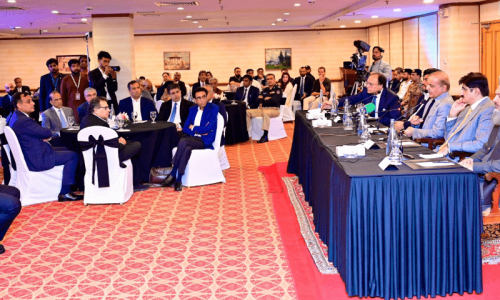ISLAMABAD, March 24: A team of Taxila Institute of Asian Civilizations, Quaid-i-Azam University, has embarked on a gigantic project to explore new dimensions of Pakistan’s rich heritage in the Soan valley. Under the supervision of internationally-known anthropologist, historian and scholar Dr Ahmad Hassan Dani, the Indusians Research Cell (IRC) consisting of geo-physicists, anthropologists, archaeologists, historians, chemists, biologists, economists and young researchers, are devoted to bring new dimensions of research about the heritage. The 86-year-old anthropologist is still energetic to work for building theological ground of ancient Pakistan.
Quaid-i-Azam University is one of the leading research institutes of the country having its natural as well as social sciences departments where multidimensional research work is going on. The QAU Vice-Chancellor Dr U.A.D. Esani is kind enough to encourage research activities in the university. Under the slogan ‘Save civilization, save mother earth’, the IRC team has recently started surface collection at eight sites at Soan valley, which is considered as the laboratory for geological, anthropological and archaeological studies.
Earlier remains of ‘anthropoid ape’ and ‘Potoharmans’, discovered by German scholars S.B. Leakey and her husband in the valley have been declared as the grandfather of human race.
The IRC team had set up its camp at a small town, Chakbeli Khan, about 60km southwest of Rawalpindi. Chakbeli Khan has an important central position in the area, wherefrom traders, travellers of the surroundings are connected with small villages of the area.
The first site was Bains or Vains as called by the local people, a 16-feet mound, spreading on an area of about four acres, surrounded by rich agricultural land. The others sites are Dhudhumber, Salmoon, Pind, Ghai, Gheela Kalan, Khai Dhok, and Banian. The landowners are extending their fields towards the mound. A mosque has recently been constructed near the mound.
There are remains of foundation walls of a complete room and two independent walls. A piece of conglomerate block is also distinguished on the surface. Pottery pieces are scattered on and around the mound even in the fields. People have found coins, pottery, jewellry and statues of various kinds during their agricultural work. During the surface collection materials like coins, pottery, terracotta, bones etc., of about three different periods were found.
Many pieces of bones of humans and animals have been collected that will need expert suggestions of physical anthropologists who may be able to determine the age and sex of individuals. It will also help us understand biological interpretations about their diet.
Numismatics of the Bains consisted of three dynasties — Muslim, the Hindu Shahi and the earliest Kushan periods. Thirty-two coins have been collected while more searches are going on. Among the other finds the main assemblage of artifacts is pottery. The entire surface of the site is littered with herds of pot shreds, bases, rims, glazed dishes, jars etc. Clay of the area is fine, making it easy to work on its surface in an artistic manner.
A huge quantity of pottery painted with animals, plants and other motifs on them tells the epic stories. It is easy to say that pottery manufacturing process consisted of quality of the clay, which are well levigated and extremely well-fired and burnt. The thickness of the pottery is 0.3 to 1.1cm.
Lingam pieces were also found during the surface collection. Terracotta of the area has significance due to its affinities with Harrapan style. Constructional remains: Three walls appear on the surface having about 5-6 feet depth in the mound, though the remaining walls are completely out of sight. One foundation of a room, measuring 8x14 feet has four walls clearly appeared on the surface, while the width of the wall is 1.5 feet.
Miscellaneous findings: though our objects were spreading around we searched unique material to join the missing links. A rich cultural complex of artifacts opened up many other dimensions in this regard. The pot shreds of various kinds had a great similarity to Kotdijian style. Like other findings our miscellaneous objects were beads, buttons, terracotta cakes, jewellry, lamps, bangles, nip of an arrow etc.
The material findings at Bains leads to many periods, survived in its dead mound, stories of different dynasties, ranging from the mature Indus valley civilization to Kushan, Hindu Shahi and Muslims.
A proper chronological order of the area could be made through institutional efforts. More attention from the government, concerned ministries, local people and scholars is needed for its protection and preservation to save the rich national heritage.—A.R. Azad Kakepoto














































Dear visitor, the comments section is undergoing an overhaul and will return soon.